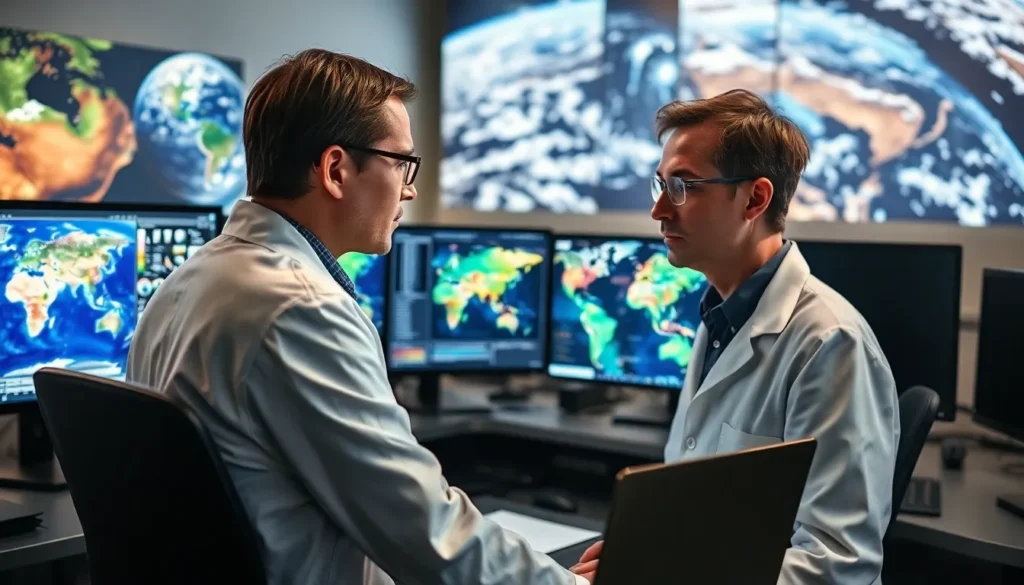Table of Contents
ToggleIn an age where information drives decision-making, satellite data analysis stands at the forefront of technological innovation. Harnessing the power of satellite imagery, experts can unlock insights that were once unimaginable. From monitoring climate change to enhancing urban planning, the applications of this technology are vast and impactful.
As the demand for accurate data grows, so does the sophistication of satellite analysis techniques. Advanced algorithms and machine learning models enable researchers to interpret complex datasets with unprecedented speed and precision. This not only aids in scientific research but also empowers businesses and governments to make informed choices that affect millions.
Understanding satellite data analysis is essential for anyone looking to navigate the complexities of our modern world. With its ability to transform raw data into actionable intelligence, it’s reshaping industries and driving progress like never before.
Overview of Satellite Data Analysis
Satellite data analysis involves the evaluation and interpretation of information gathered from satellites in orbit around Earth. This analysis converts raw data into meaningful insights. Various techniques play a crucial role, including image processing, statistical methods, and machine learning algorithms.
Key Components of Satellite Data Analysis
- Data Collection: Satellites equipped with sensors capture images and measurements across multiple wavelengths. These sensors gather diverse data types, such as optical imagery, radar signals, and thermal readings.
- Data Processing: Data undergoes preprocessing to enhance quality and remove noise. Techniques like geometric correction and radiometric calibration ensure the accuracy of satellite imagery.
- Data Interpretation: Analysts employ various approaches for interpreting satellite data. Machine learning models and statistical analyses provide insights into environmental conditions, land use, and resource management.
Applications of Satellite Data Analysis
- Climate Change Monitoring: Satellite data enables tracking of environmental changes, including temperature fluctuations and deforestation rates. Continuous monitoring supports climate science and policy development.
- Urban Planning: Satellite imagery assists in urban development projects, facilitating mapping of infrastructure and population density trends. Planners can visualize changes and make informed decisions based on current data.
- Disaster Response: In emergency situations, satellite data aids in disaster assessment and response efforts. Real-time imagery allows for damage assessment, resource allocation, and planning of recovery operations.
Technologies in Satellite Data Analysis
- Geographic Information Systems (GIS): GIS integrates satellite imagery with spatial data, enabling complex analyses and visualizations of geographic patterns.
- Cloud Computing: Utilizing cloud platforms for data storage and processing enhances scalability and accessibility. Analysts can access large datasets without the limitations of traditional computing capabilities.
- Artificial Intelligence (AI): AI enhances satellite data analysis by improving accuracy in identifying patterns and automating image classification tasks. This technology accelerates insights generation and broadens analytical capabilities.
Satellite data analysis stands at the forefront of technological advancement, offering essential insights across various sectors. As methodologies evolve, the accuracy and applicability of satellite data continue to expand, empowering informed, data-driven decisions.
Key Applications of Satellite Data Analysis

Satellite data analysis plays a crucial role in various sectors by providing timely insights and improving decision-making capabilities. The following key applications demonstrate its significance.
Environmental Monitoring
Environmental monitoring utilizes satellite data to track changes in ecosystems and natural resources. Analysts employ satellite imagery to assess deforestation rates, monitor water quality, and study habitat alterations over time. For instance, the European Space Agency’s Copernicus program offers detailed land observation data that supports biodiversity conservation initiatives. Additionally, satellite sensors measure greenhouse gas concentrations, aiding researchers in understanding climate change impacts.
Disaster Management
Disaster management benefits greatly from satellite data analysis, particularly in response and recovery efforts. Satellites provide real-time imagery of affected areas, allowing agencies to assess damage and coordinate relief operations efficiently. For example, after natural disasters like hurricanes or earthquakes, satellite data aids in mapping affected regions, identifying infrastructure damage, and directing resources to where they’re most needed. The National Oceanic and Atmospheric Administration (NOAA) utilizes satellite data to forecast weather events, enhancing preparedness strategies.
Urban Planning
Urban planning leverages satellite data to inform infrastructure development and land use strategies. Planners analyze high-resolution satellite images to monitor urban sprawl, assess transportation needs, and optimize land allocation. This data enables cities to develop sustainable growth models by identifying green spaces and assessing urban heat islands. Furthermore, tools like Geographic Information Systems (GIS) combine satellite data with demographic information, allowing planners to create more effective policies that address urban challenges.
Techniques Used in Satellite Data Analysis
Satellite data analysis employs a variety of techniques to extract meaningful information from vast datasets. These methodologies enable precise insights across multiple sectors.
Remote Sensing
Remote sensing involves collecting data from satellites using sensors that capture electromagnetic radiation across different wavelengths. This technique enables the analysis of land use, vegetation cover, and atmospheric conditions. Sensors can be passive, relying on natural sunlight to capture images, or active, emitting energy to gather information. For instance, multi-spectral and hyperspectral imaging sensors allow for detailed classification of materials on Earth’s surface, essential in fields like agriculture and environmental monitoring. By integrating images over time, analysts can assess changes, track deforestation, or monitor urban growth.
Machine Learning Approaches
Machine learning approaches enhance satellite data analysis by automating data processing and interpretation. Algorithms recognize patterns in large datasets, improving accuracy and efficiency. Techniques such as supervised learning apply pre-labeled data to train models, enabling them to predict outcomes for new datasets. Unsupervised learning identifies inherent patterns without prior labeling, useful for clustering similar data points. Deep learning, a subset of machine learning, employs neural networks to analyze complex datasets. These methods support applications like object detection, land classification, and anomaly detection, significantly reducing the time and effort needed for manual analysis.
Challenges in Satellite Data Analysis
Satellite data analysis faces several critical challenges that can impact its effectiveness and reliability. Key obstacles include data quality issues and limitations in processing and storage capabilities.
Data Quality Issues
Data quality issues frequently arise during satellite data analysis. Inconsistent data may result from sensor calibration errors, atmospheric disturbances, or obstructions that impede data collection. Variable resolution among different satellite platforms can also lead to discrepancies. Heavily cloudy or foggy conditions can further obscure images, rendering them less useful. Ensuring accuracy involves meticulous calibration processes and error correction techniques to maintain reliable data integrity.
Processing and Storage Limitations
Processing and storage limitations present additional challenges. Satellite data generates vast volumes of information, requiring substantial computational power for analysis. Not every organization possesses the infrastructure necessary for high-capacity data processing. Limited processing capabilities can slow down analysis, delaying timely insights. Additionally, storing large datasets poses logistical challenges, with adequate storage solutions needed to manage and retrieve data efficiently. Effective cloud storage and advanced processing technologies can mitigate these obstacles, yet many practitioners still face significant hurdles in managing the required resources.
Satellite data analysis is revolutionizing how industries approach problem-solving and decision-making. Its ability to convert raw data into meaningful insights is essential for tackling pressing global challenges. As technology continues to evolve, the integration of machine learning and advanced processing techniques will enhance the accuracy and efficiency of data interpretation.
The ongoing advancements in satellite technology and data analysis methodologies are paving the way for more informed strategies across sectors. By harnessing these capabilities, organizations can better respond to environmental changes, optimize urban development, and improve disaster management efforts. The future of satellite data analysis holds immense potential for driving progress and fostering sustainable practices worldwide.







